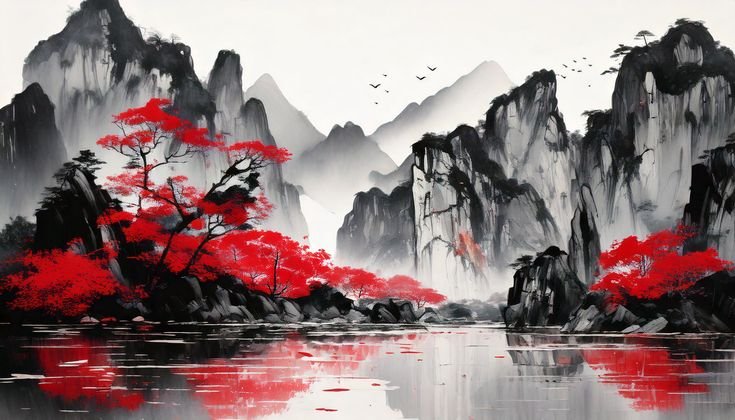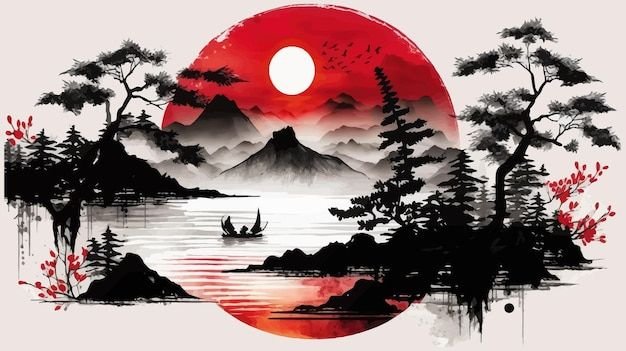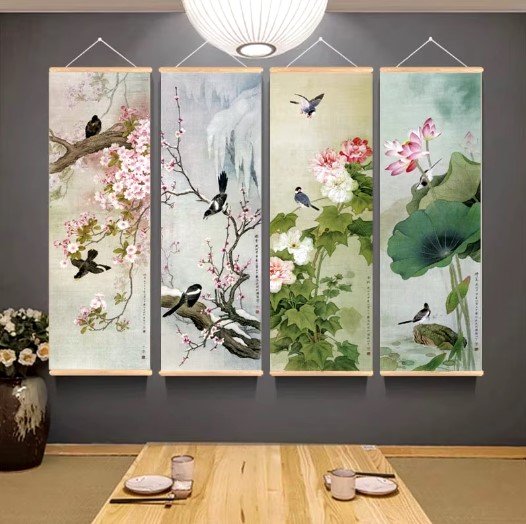Chinese ink painting, also known as Shui Mo Hua (水墨画), is one of the oldest and most respected art forms in the world. Its characteristics of Chinese ink painting make it unique compared to other painting styles. Unlike Western art, which often focuses on realistic colors and fine details, Chinese ink painting emphasizes spirit, simplicity, and emotion. Each brushstroke is carefully applied to capture not only the appearance of the subject but also its life, energy, and inner meaning.
The art form is deeply connected to Chinese philosophy, calligraphy, and cultural traditions. It reflects the influence of Taoism, Confucianism, and Buddhism, allowing artists to convey harmony with nature, moral order, and spiritual contemplation. Minimalism, tonal variations, and expressive brushwork are key features that define the style, while symbols from nature add layers of meaning.
Understanding the characteristics of Chinese ink painting helps viewers appreciate its depth and timeless beauty. Every painting is more than an image; it is an expression of thought, feeling, and philosophy. In this guide, we will explore these characteristics in detail, showing how each element contributes to the essence of Chinese ink painting.
Table of Contents
Characteristics of Chinese ink painting Philosophy and Spiritual Meaning
Chinese ink painting is deeply connected to philosophy and spirituality, which is one of its most defining characteristics.
- Philosophical influences: The main influences are Taoism, Confucianism, and Buddhism. Taoism emphasizes harmony with nature, encouraging artists to capture the balance and rhythm of natural landscapes. Confucianism focuses on order and moral values, reflected in carefully structured and harmonious compositions. Buddhism brings a meditative quality, allowing paintings to express peace and contemplation.
- Spiritual essence: Unlike realistic Western art, Chinese ink painting aims to capture the spirit of the subject, not just its appearance. Artists strive to convey energy, emotion, and philosophical meaning through each brushstroke.
- Connection to human life: Paintings are often a reflection of human experience, thought, or moral lessons. Philosophical guidance shapes how the artist observes nature and expresses their inner thoughts.
- Guide: To create this effect, focus on observing your subject carefully, understanding its rhythm, and expressing it in fluid, thoughtful strokes. Each painting should communicate more than the visible form it should convey feeling, life, and thought.
Spirit and Life: Qiyun (Spirit Resonance)
A key concept in Chinese ink painting is Qiyun (气韵), which means spirit resonance. This is considered the heart of the art, defining its life and vitality.
- Essence over form: Qiyun focuses on capturing the inner energy of the subject, rather than only its visual appearance.
- Energy in strokes: Every brush stroke carries movement and emotion, making the subject appear alive and dynamic.
- Interaction with the artist: The artist’s own understanding and feelings are transmitted into the work, creating a bond between the observer, subject, and painter.
- Guide: To achieve Qiyun, practice using varying brush pressures, rhythm, and ink flow. Focus on expressing life force rather than details. Observe the subject carefully and imagine its spirit before painting.
Brushwork and Techniques
Brushwork is one of the most important characteristics of Chinese ink painting. The way lines and strokes are applied defines the shape, movement, and emotion of the work.
- Line quality (Gufa / Bone Method): The strength, angle, and flow of brush lines are essential. Strong, deliberate lines give structure, while soft, light lines create gentle forms.
- Ink handling: Artists use tonal variations and different amounts of water in the ink to create depth, shadows, and texture. Techniques include dry brush, wet brush, and layered washes.
- Expressive strokes: Each stroke should carry emotion. Movement can suggest calmness, speed, energy, or tranquility depending on pressure and speed.
- Guide: Master the brush by practicing different pressures and angles. Focus on flow and rhythm, as every stroke communicates character and feeling. Avoid over-detailing; simplicity often conveys more emotion.
Simple and Minimal Design
Simplicity and minimalism are core characteristics of Chinese ink painting.
- Negative space: Blank areas are intentionally left in the composition. They balance the painted areas and give a sense of breathing space.
- Minimal strokes: Only a few well-placed lines can represent mountains, trees, or animals. This encourages imagination in the viewer’s mind.
- Balance and harmony: The placement of elements is carefully considered. Every stroke and empty space contributes to the overall balance of the painting.
- Guide: Use fewer strokes but with intention. Let empty spaces speak as much as painted areas. Aim for clarity, harmony, and visual simplicity.

Calligraphy and Scholar Tradition
Chinese ink painting is closely tied to calligraphy and the literati tradition, which adds intellectual depth to the art.
- Integration with calligraphy: Paintings often include written inscriptions, poems, or the artist’s signature, adding meaning and expression.
- Scholar artists: Traditionally, educated scholars painted to express their personal thoughts, emotions, and philosophy. They valued expression more than realism.
- Guide: When creating art, consider combining short inscriptions or brush-written phrases with your painting. Focus on expressing personal ideas and style, not just accuracy.
Tonal Shades and Monochrome Art
Chinese ink painting primarily uses black ink, but varying the tone and density creates richness.
- Shading and depth: Light and dark areas help create a sense of distance, volume, and form.
- Texture and atmosphere: Different ink densities can suggest fog, water, or mountain slopes, giving the painting life.
- Skill in monochrome: Using only black ink requires control and planning, making tonal mastery a key characteristic.
- Guide: Practice mixing ink with water to achieve different shades. Use light washes for distant areas and darker, bold strokes for foreground objects. Tonal contrast adds emphasis and visual interest.
Symbols and Meaning
Symbolism is an important feature of Chinese ink painting. Many subjects carry cultural and philosophical significance.
- Nature motifs: Bamboo symbolizes strength, plum blossoms represent hope, and mountains show stability.
- Animals: Birds, fish, and mythical creatures often convey virtues, luck, or spiritual ideas.
- Guide: When painting, think about what each element represents. Use symbols to convey deeper meaning. Simple motifs can communicate ideas clearly without overcomplicating the composition.

Conclusion
The characteristics of Chinese ink painting make it a unique and enduring art form admired worldwide. Its focus on spiritual expression, Qiyun (spirit resonance), and philosophical depth sets it apart from other painting styles. Through careful brushwork, tonal variations, and minimalistic design, artists convey not just the appearance of subjects but their inner life and energy.
Calligraphy and the literati tradition further enrich the art, allowing painters to combine writing, poetry, and painting into a harmonious expression of thought and emotion. Symbolism adds layers of meaning, connecting the viewer to nature, philosophy, and cultural values. Every brushstroke carries intention, creating a balance between simplicity and depth.
Understanding these characteristics helps viewers appreciate Chinese ink painting as more than just a visual art, it is a reflection of human thought, feeling, and harmony with nature. Its timeless appeal lies in its ability to communicate emotion, philosophy, and beauty through simple yet profound strokes. By exploring these characteristics of Chinese ink painting, we can fully understand why this art form continues to inspire artists and audiences around the world.

